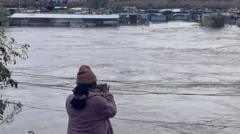**A university student faced significant danger at Mount Fuji after his attempts to recover a lost phone led to two rescue missions, raising alarms about climbing safety protocols.**
**Climber Rescued Twice on Mount Fuji After Losing Mobile Phone**

**Climber Rescued Twice on Mount Fuji After Losing Mobile Phone**
**A young student defies safety warnings, prompting concerns over climbing outside the official season.**
In an unusual series of events, a 27-year-old Chinese university student residing in Japan found himself in peril while climbing Mount Fuji outside of the designated climbing season. The climber, who ventured onto the mountain in search of a lost mobile phone, was rescued twice within a four-day span, highlighting the risks associated with climbing during unsafe periods.
The student initially met with trouble on Tuesday while traversing the Fujinomiya trail, which reaches an elevation of approximately 3,000 meters (9,800 feet). He lost his crampons — essential equipment providing better traction on slippery terrain — which rendered him unable to safely descend. A helicopter was dispatched for his rescue, bringing him to safety.
In a surprising twist, the climber returned to the mountain days later to retrieve his belongings, including the lost phone. Unfortunately, this second attempt led to even graver circumstances as he experienced altitude sickness. Rescuers were once again called on Saturday, and although he has since recovered, the incident stirred renewed concern among authorities.
Officials from the Shizuoka prefecture issued a stern reminder against climbing Mount Fuji outside its official climbing season, which runs from early July to September. During this time, all routes to the summit are closed, and climbers face the risk of sudden weather changes that can jeopardize both their safety and rescue efforts. Furthermore, medical facilities along the trails are unavailable out of season.
Public response to the climber's actions included criticism on various social media platforms, with calls for him to bear the financial consequences of the rescue missions. Mount Fuji, famed for its striking cone shape, is a revered symbol of Japan and an attraction for countless hikers. However, as overtourism continues to challenge its delicate ecosystems, authorities have raised climbing fees in recent years; over 220,000 climbers scaled the mountain during the sanctioned months of 2023 alone.
The student initially met with trouble on Tuesday while traversing the Fujinomiya trail, which reaches an elevation of approximately 3,000 meters (9,800 feet). He lost his crampons — essential equipment providing better traction on slippery terrain — which rendered him unable to safely descend. A helicopter was dispatched for his rescue, bringing him to safety.
In a surprising twist, the climber returned to the mountain days later to retrieve his belongings, including the lost phone. Unfortunately, this second attempt led to even graver circumstances as he experienced altitude sickness. Rescuers were once again called on Saturday, and although he has since recovered, the incident stirred renewed concern among authorities.
Officials from the Shizuoka prefecture issued a stern reminder against climbing Mount Fuji outside its official climbing season, which runs from early July to September. During this time, all routes to the summit are closed, and climbers face the risk of sudden weather changes that can jeopardize both their safety and rescue efforts. Furthermore, medical facilities along the trails are unavailable out of season.
Public response to the climber's actions included criticism on various social media platforms, with calls for him to bear the financial consequences of the rescue missions. Mount Fuji, famed for its striking cone shape, is a revered symbol of Japan and an attraction for countless hikers. However, as overtourism continues to challenge its delicate ecosystems, authorities have raised climbing fees in recent years; over 220,000 climbers scaled the mountain during the sanctioned months of 2023 alone.























